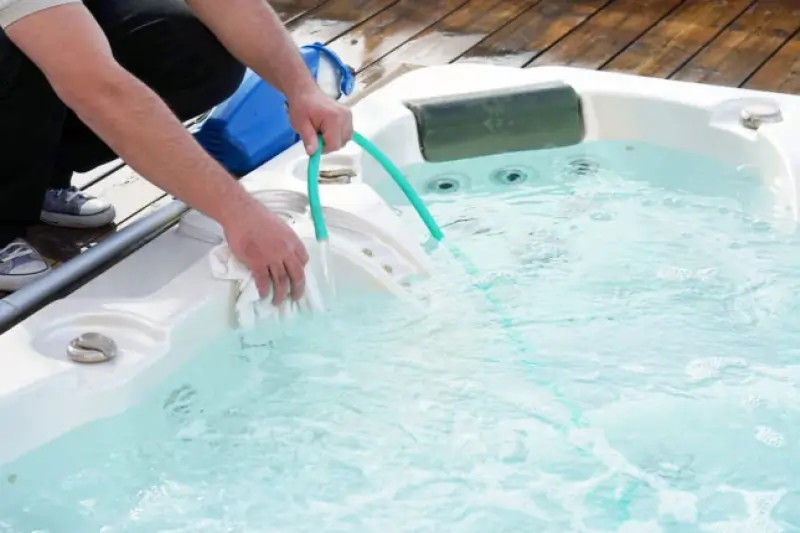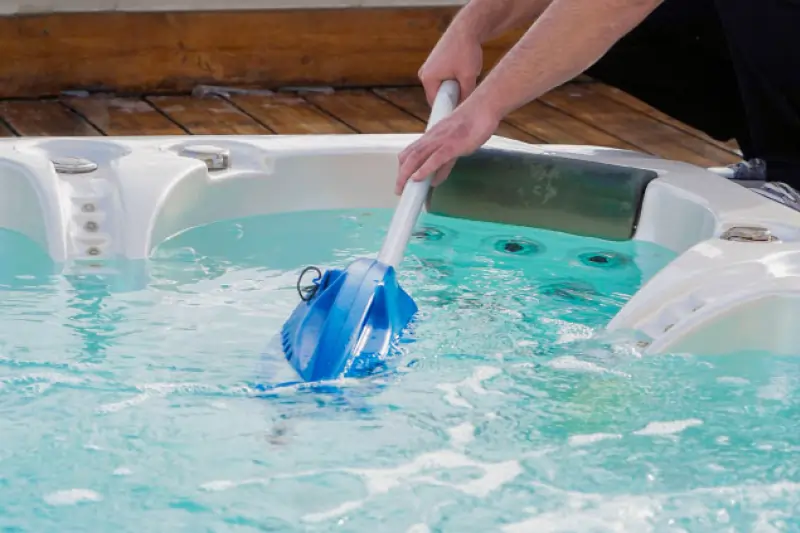Embarking on the thrilling journey of hot tub ownership? Whether you’re a novice spa enthusiast or a seasoned soaker seeking a refresher on spa care, our hot tub water care guide is your key to unlocking a perpetually ready, crystal-clear, and sanitized hot tub haven. Let’s dive into the easy steps to elevate your water care rituals.

Step 1: Chemical Balance
Balancing spa water is a vital aspect of hot tub maintenance, akin to conducting a symphony for an optimal soak. Begin by testing the water 2-4 times a week using a reliable kit, adjusting pH, alkalinity, calcium hardness, and sanitizer levels as needed to create clean and clear spa water. Keep chlorine levels between 1.0–3.0 ppm or bromine levels at 2.0–4.0 ppm, with pH ideally between 7.4–7.6, total alkalinity ranging from 80–120 ppm, and calcium hardness at 150–250 ppm. Utilize water spa-friendly chemicals to fine-tune these parameters. Regularly check the water’s pH and alkaline levels, especially after a water change, or after a lot of use and adjust to maintain balance. This meticulous balancing act ensures not only crystal-clear and inviting water but also preserves the longevity of your spa’s components, offering a pristine oasis for relaxation.
Step 2: Filter Care
The filter in your hot tub plays a crucial role, responsible for removing bacteria and contaminants from the water. If the filter becomes dirty or damaged, it can compromise its efficiency, leading to the potential presence of harmful substances in your hot tub. This, in turn, necessitates more frequent water treatments and places additional strain on your system to maintain the tub’s cleanliness. To ensure optimal performance, it’s advisable to rinse the filter every 1-2 weeks and periodically soak it in a high-quality filter cleaner. This routine helps eliminate accumulated grime, ensuring the spa filter can effectively fulfill its role. The lifespan of your filter varies based on hot tub usage but, generally, a good-quality hot tub filter should endure for 1-2 years. Regular inspections are essential, and if any signs of wear emerge, it’s prudent to replace the filter promptly. An indication for replacement is when the filter no longer responds well to standard cleaning during your routine hot tub maintenance.
Step 3: Draining
Regularly draining your spa water every six months is a crucial practice in maintaining clean and balanced hot tub water. Over time, various impurities, contaminants, and dissolved solids can accumulate in the water, diminishing the efficacy of the chemicals and disrupting the delicate balance necessary for a healthy spa. Draining the water allows for a fresh start, removing these accumulated substances and providing a clean slate for proper chemical application. It is particularly beneficial when the existing chemicals are no longer performing optimally or have strayed outside their specific range. This proactive measure not only enhances the effectiveness of subsequent spa chemical treatments but also promotes clearer, more inviting water.
Step 4: Cover Care
Using a cover when the hot tub is not in use provides insulation, retaining heat and conserving energy, thus reducing heating costs. Additionally, it prevents debris, leaves, and contaminants from entering the water, maintaining water quality, and minimizing the need for frequent cleaning. Regularly cleaning the cover is essential to prevent the accumulation of dirt, mold, or mildew, ensuring a hygienic and aesthetically pleasing appearance. Consider the option of applying a protective coating to the cover, this can significantly enhance its lifespan. This coating acts as a shield, safeguarding the cover against UV rays, harsh weather conditions, and wear and tear. By adopting a comprehensive approach to hot tub cover care, including proper usage, regular cleaning, and the application of protective coatings, you not only extend the cover’s longevity but also contribute to efficient energy usage and a cleaner, more enjoyable hot tub experience.

Step 5: Water Top-Off
Ensuring the water level is within the specified range, typically in the middle of the skimmer intake or slightly higher than the highest jet, safeguards the pump from potential damage caused by sucking in air. Consistent water levels contribute to the efficiency of the filtration system, preventing air ingestion that might compromise pump function. Keeping your spa water level at the correct depth not only safeguards the equipment but also ensures proper water circulation and efficient filtration.
Step 6: Circulate The Water Daily
Daily circulation of the water in your hot tub is a fundamental practice that significantly contributes to the overall health and longevity of the spa. This regular water movement serves as a preventive measure against stagnation, minimizing the risk of bacterial growth and enhancing the efficiency of the filtration system. Some hot tubs come equipped with user-friendly controls that allow you to schedule and automate this circulation process, making it even more convenient. By programming the controls to circulate the water at set intervals, you ensure that impurities are consistently filtered out, maintaining water clarity and quality. This proactive approach not only promotes a cleaner and safer hot tub environment but also optimizes the performance of your spa’s equipment.

Step 7: Skim The Surface and Vacuum Regularly
Skimming, accomplished with a simple net, efficiently eliminates floating large debris like leaves, bugs, and other contaminants, preventing them from settling into the water. This routine maintenance not only enhances the overall aesthetic appeal of your hot tub but also curtails the risk of potential clogs in the filtration system. Additionally, for more substantial debris concerns, employing a spa vacuum is essential. This specialized tool, whether battery-powered or manual, enables the thorough removal of dirt and particles that might accumulate on the surfaces and in the corners of the seats or footwell. By diligently skimming and vacuuming, you actively contribute to maintaining water clarity and purity, reducing the load on the filtration system, and fostering a hygienic environment for a consistently enjoyable hot tub experience.
In conclusion, mastering the art of spa water care isn’t as hard as it seems. By diligently following the seven essential steps outlined above, encompassing proper water balance, regular filter maintenance, drainage, cover care, water top-offs, daily circulation, and vigilant debris removal, you ensure the longevity of your spa and the clarity of its water. Each step plays a crucial role in maintaining a pristine and inviting environment, contributing to both the well-being of your hot tub and the overall quality of your relaxation experience. By adopting these practices, you not only safeguard the essential components of your spa but also create a soothing sanctuary where crystal-clear water awaits, ready to envelop you in a world of tranquility and bliss.

